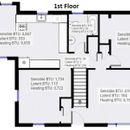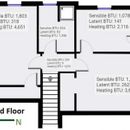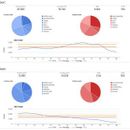Manual J questions for a New England Cape
Hi guys – Long time lurker and fan of this website & Martin’s books, and I’m finally ready to ask a Manual J question to you guys (and hopefully contribute as I learn more!).
We live in a 1960’s 2 story dormer cape near Hartford, CT (1530 sq ft conditioned + unconditioned basement), and my wife has been asking to have real “A/C” for a few years. With our oil furnace getting long in the tooth, I figured a mini-split might be a good future proof option as we gradually go greener. Next step is Manual J! I modeled the house in a weekend with the iPhone, a tape measure, & MagicPlan (what an amazing & free app!), then entered the details into CoolCalc.com’s Manual J (MJ) calculator.
The heating results are close to what I expected when compared to my oil bill’s k-factor (38kBTU with 8.04 Oil K-factor vs 34kBTU CoolCalc ManualJ). Calculating cooling loads is new for me, since we have only used window units for spot cooling rooms in the past.
Here goes:
1. How should stairs get modeled for Manual J? Do I split the area for the first floor (Zone 1) and 2nd floor (Zone 2)?
2. Is warm air buoyancy accounted for if upstairs doors are left open? (less heat 2nd floor and more A/C). If not, should I adjust for it?
3. Do I model the original brick fireplace wall area as a window pane since the R-value of brick is poor, or is that overkill and should be ignored?
4. How should infiltration be modeled for both zones? Do I take our 1610 cfm @ Pa50 and divide by 2 for the upstairs and downstairs zone (since stack effect goes across both zones)? Or allocate by floor area %?
5. How should basement wall and sill plate insulation be modeled (since it’s not a conditioned area, but would affect heat load on the 1st floor). It’s currently not insulated at all, but is on my wish list. We’ve got 10″ thick concrete walls, 5′ below grade with 2′ above and five ancient single pane steel framed casement windows.
6. Dana often mentions a high A/C latent heat load in New England, but the CoolCalc.com calculations have my SHR at .904 downstairs and .84 upstairs (88°F design temp). Is that in the ballpark? I don’t know what to expect…
7. Should I bother doing a ManualJ for the basement, with a 55deg inside temp to see how that affects the whole-house load? Would that be included to the first floor because of conduction (hardwood floor over plywood subfloor).
Thanks for sharing the wealth of knowledge here! I’ve learned a ton on this journey, and am looking forward to getting our house more efficient.
Andris
GBA Detail Library
A collection of one thousand construction details organized by climate and house part












Replies
> CoolCalc.com calculations have my SHR at .904
Perhaps on design day. On a 75F, humid day, the SHR will be zero.
Good question about accounting for buoyancy. It's highly dependent on mixing.
Using a K-factor of 8.04 and a design temp of +6 and a combustion efficiency of 85% I come up with ~36K for a heat load, not 38K, and that's an extreme upper bound. With a boiler in an uninsulated basement the idling and distribution losses probably bring the as-used net efficiency down to 75% or less, but it's all the right ball park (and at more than 20BTU/hr per square foot arguably too high for a ~1500' house). Reality is probably ~30K-ish. Try running loadcalc.net for a second opinion to the Coolcalc numbers.
If the basement isn't insulated and it's air-leaky it's going to be a lot colder than 55F down there during cold snaps. An uninsulated basement with a 2' exposure on the foundation above grade could easily be 15-25% of the total heat load even if the basement is allowed to drop to 50F. Insulated to R15 continuous (current code min) and air sealed the basement would probably never drop below 60F even without the idling losses of a boiler heating it up. Go ahead and run the Manual-J on the basement assuming 50F indoors in it's uninsulated mode, then again at 65F with R15 continuous insulation to get a handle on just how big that loss is.
The losses due to the uninsulated basement may already be built into the calculated floor losses for the first floor, which is why it's twice the load of upper floor, but the resolution on the pie charts in the attached image isn't good enough to say for sure.
The conducted heat losses of brick fireplaces are comparable to triple-wythe brick, which would come in around U0.30-U0.35, comparable to that of a code-min window. But the air leakage at the fireplace may account for the lions-share of your 1610 cfm/50 leakage numbers.
The cfm/50 isn't the same as your infiltration rates. Converting that number to the natural infiltration rate is a very squishy number, since it matters WHERE the leaks are. For a southern New England location dividing the number by 20 or 25 will ball-park it for estimation purposes, but it could easily be half that or twice that depending on the locations of the leaks.
It's not that latent loads are particularly high in New England, but in a higher performance houses there are days when it's the ONLY load. An SHR of 0.84- 0.90 is an indication that only 10-16% of the PEAK load is latent, and any mini-split sized for the load would handle the humidity on peak cooling days in normal cooling mode. But when it's just 75-80F and ultra muggy it will be worth switching to DRY mode for awhile.
The load tools don't usually model the convection up/down staircases, but the total load of the stairwell is within the margin of error of the floor by floor zone numbers anyway.